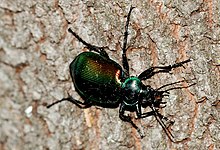Doll robber
| Doll robber | ||||||||||||
|---|---|---|---|---|---|---|---|---|---|---|---|---|

Doll robber |
||||||||||||
| Systematics | ||||||||||||
|
||||||||||||
| Scientific name | ||||||||||||
| Calosoma | ||||||||||||
| Weber , 1801 |
The pupa robbers ( Calosoma ) are a genus from the family of ground beetles (Carabidae). They are very conspicuous beetles with a body size of 16 to 30 millimeters. Five species of this genus live in Central Europe, three of which can also be found in Germany.
features
The most noticeable feature of the doll robbers is the pronotum, which is significantly wider than it is long. At the transition to the wing covers, however, it is narrower than that of the real ground beetles , which creates an indicated waist. The coloration of the animals varies, but is often metallic green, purple or blue, the gold dot pupa predator is black and has golden spots on the elytra . The beetle's mandibles are long and strong and reinforced with teeth; there is no tactile bristle on the mandible. Further identifying features are the four bare antennae base members, the bristle above the eye and the position of the end spine of the anterior splint ( tibia ) at the end.
Way of life
As the name suggests, pupa predators are predatory ground beetles that feed primarily on butterfly larvae. They are known and appreciated as a destroyer of harmful caterpillars such as the Silver Y ( Autographa gamma ), the pine beauty ( Panolis flammea ), the gypsy moth ( Lymantria dispar ) and the nun ( Lymantria monacha ). The large pupa predator ( Calosoma sycophanta ) and the small pupa predator ( C. inquisitor ) and their larvae live in trees, the other species mainly hunt on the ground. All doll robbers are considered good fliers.
The lifespan of the beetles can be three to four years, but the larval period lasts only two to three weeks. The eggs are laid in the ground. Especially when caterpillars appear in large numbers, the beetles also appear very frequently locally. The wintering takes place as an imago .
species
Five species of the genus Calosoma live in Central Europe , three of which can also be found in Germany. In general, the pupa predators are united with the real ground beetles ( Carabus ) and the genus Procerus in a subfamily Carabinae. All types of doll robbers in Germany are protected by the Federal Species Protection Ordinance.
- Large pupa predator ( Calosoma sycophanta )
- Little doll robber ( Calosoma inquisitor )
- Gold dot pupa predator ( Calosoma auropunctatum )
- Reticulated pupa predator ( Calosoma reticulatum )
- Calosoma investigator
Threat and protection
The main threat to pupa predators comes from the use of insecticides and from the decline in the animals' natural habitats, especially the dry grassland . In Germany and other Central European countries, all species of doll robbers are accordingly under nature protection.
literature
- E. Arndt: Family Carabidae. In: B. Klausnitzer (Hrsg.): The larvae of the beetles of Central Europe 1, Adephaga. Goecke & Evers, Krefeld 1991, ISBN 3-87263-041-5 .
- German Youth Association for Nature Observation (DJN): ground beetles. 4th edition. 2006, ISBN 3-923376-18-9 . (Identification key for all genera)
- H. Joy: Adephaga, 1. Carabidae. In: H. Freude, KW Harde, GA Lohse (Ed.): Die Käfer Mitteleuropas. Volume 2, Goecke & Evers, Krefeld 1976, ISBN 3-87263-025-3 .
- Ekkehard Wachmann , Ralph Platen, Dieter Barndt: Ground beetles - observation, way of life. Naturbuch-Verlag, Augsburg 1995, ISBN 3-89440-125-7 .
- RM Weseloh: Predation by Calosoma sycophanta (Coleoptera, Carabidae): evidence for a large impact on gypsy moth, Lymanthria dispar L. pupae. In: The Canadian Entomologist. 117, 1985, pp. 1117-1126.
- Jiři Zahradnik, Irmgard Jung, Dieter Jung and others: Beetles of Central and Northwestern Europe. Parey, Berlin 1985, ISBN 3-490-27118-1 .
Web links
- Calosoma at Fauna Europaea
